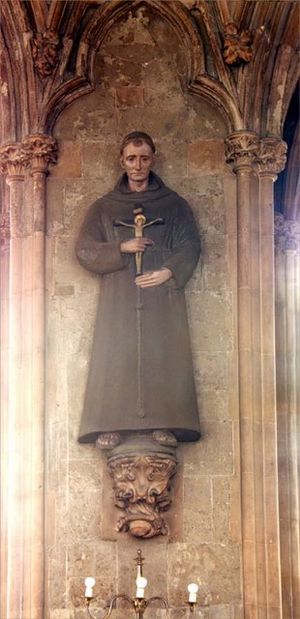John Forest facts for kids
Quick facts for kids BlessedJohn Forest O.F.M. |
|
|---|---|

Bl. John Forest, nave statue – St. Etheldreda, Ely Place, London
|
|
| Martyr | |
| Born | c. 1471 Oxford |
| Died | 22 May 1538 (aged 66 - 67) Smithfield, London |
| Honored in | Roman Catholic Church |
| Beatified | 29 December 1886 by Pope Leo XIII |
| Feast | 22 May |
| Attributes | Franciscan habit, crucifix, martyr's palm, chains, being burnt above a burning statue |
John Forest (born around 1471 – died 22 May 1538) was an English Franciscan friar and a martyr. A friar is a member of a religious group, like a monk, who often lives among people. John Forest was a special advisor, called a confessor, to Queen Catherine of Aragon. He was executed in London because he refused to accept King Henry VIII as the head of the Church in England. This was seen as a serious crime against the king and his new laws.
Contents
The Life of John Forest
John Forest was born near Oxford in 1471. In 1491, he joined the Franciscan friars in Greenwich. These friars were known for following strict religious rules. John Forest studied theology, which is the study of religious beliefs, at the University of Oxford.
Becoming a Leader and Royal Confessor
Later, he became the leader of all the Franciscan friars in England. He also became the confessor to Queen Catherine of Aragon, who was King Henry VIII's first wife. The friary in Greenwich was very close to the Royal Palace.
Conflict with King Henry VIII
King Henry VIII wanted to change the Church in England. He wanted to divorce Queen Catherine, but the Pope would not allow it. The King also wanted to be the head of the Church himself. He tried to get important and respected people to agree with his plans. Those who agreed were offered rewards, but those who disagreed faced threats.
From 1531, the Franciscan friars, including John Forest, opposed the King's divorce. They also disagreed with his moves towards Protestantism, a new form of Christianity.
Imprisonment and Resistance
In November 1532, John Forest, as the leader of the Greenwich friary, warned his fellow friars about the King's plans. He also publicly spoke against the King's divorce plans. In 1533, he was put in Newgate prison and sentenced to death.
In 1534, King Henry VIII closed down the Franciscan friaries and sent the friars away. John Forest was released from prison, but by 1538, he was held again. This time, he was in a different Franciscan friary in Smithfield. His death sentence had not been carried out yet.
Standing Firm in Beliefs
Even though John Forest had at first changed his mind about some things, he was held in Newgate Prison again. This was because he denied that the King was the supreme head of the Church. Other friars in prison with him encouraged him to stick to his Catholic beliefs.
His imprisonment was not very strict. He was allowed to lead Mass (a Catholic church service) and listen to people's confessions. From prison, he could even write to the Queen. He also wrote a paper called De auctoritate Ecclesiae et Pontificis maximi. This means "On the Authority of the Church and the Supreme Pontiff." In this paper, he argued that the Pope was the head of the Church and that the Church should be independent from the government.
He was reported to the King for this paper. He also refused to swear the Oath of Supremacy. This oath was a promise to accept the King as the head of the Church, and it was demanded by Thomas Cromwell, a powerful advisor to the King.
Trial and Execution
Archbishop Thomas Cranmer and Hugh Latimer worked for Thomas Cromwell to bring about John Forest's trial. Forest was found guilty of high treason (a serious crime against the country) and heresy (beliefs that go against official Church teachings). He was accused of heresy because he opposed the King's idea that the ruler should control the Church.
It was common at the time for a bishop to give a final sermon at an execution. Bishop Latimer was chosen to preach, urging John Forest to change his mind. But John Forest did not give in.
On 22 May 1538, John Forest was burned to death at Smithfield, London. He was hung over the fire in chains. He was the only Catholic martyr to be burned at the stake during the English Reformation. People say that extra wood for the fire came from a very large statue of Saint Derfel from Wales. There was a prophecy that this statue would "one day set a forest on fire."
Honoring John Forest
John Forest, along with 53 other English martyrs, was officially recognized as "Blessed" by Pope Leo XIII on 9 December 1886. This is a step towards being declared a saint.
You can find a statue of John Forest in the church of St. Ethelreda in Ely Place, London. There is also a mosaic of him in the Holy Name of Jesus Roman Catholic Church in Chorlton-on-Medlock, Manchester.
Stained glass windows showing John Forest can be seen in these churches:
- Our Lady and the English Martyrs, in Cambridge
- Shrewsbury Cathedral, where he is the first figure on the fifth window, next to Edmund Campion.

